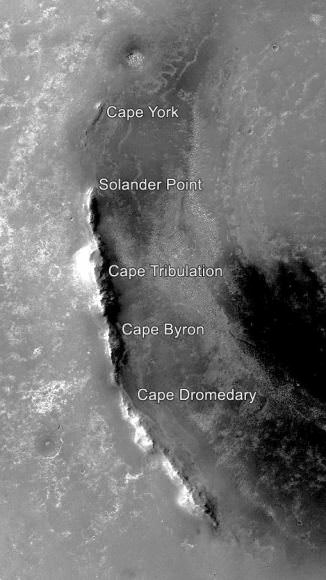You'd have to be an intrepid explorer to investigate something named 'Cape Tribulation'. Opportunity, NASA's long-lived rover on Mars' surface, has been just that. But Opportunity is now leaving Cape Tribulation behind, after being in that area since late 2014, or for about 30 months.
Cape Tribulation is the name given to a segment of crater rim at Endeavour Crater, where Opportunity has been for over 5 1/2 years. During that time, Opportunity reached some important milestones. While there, it surpassed 26 miles in distance travelled, the length of a marathon race. It also reached its highest elevation yet, and in 'Marathon Valley', it investigated clay outcrops seen from orbit. Opportunity also had some struggles there, when its flash memory stopped working, meaning all data had to be transmitted every day, or lost.

Sol 3906, January 19, 2015. Summit panorama from Cape Tribulation from the Opportunity Mars Rover. Credit: NASA/Arizona State University.
Before reaching Cape Tribulation 30 months ago, Opportunity investigated other parts of Endeavour Crater called "Cape York," "Solander Point" and "Murray Ridge."

Some of the named features at Endeavour Crater. Image: NASA/JPL-Caltech/MSSS
The rover's next destination is Perseverance Valley, where it will investigate how it was carved out billions of years ago: by water, by wind, or perhaps flowing material lubricated by water. Before leaving Cape Tribulation, Opportunity captured the panoramic image of Rochefort Ridge, a section of the Endeavour Crater rim marked by grooves on its side."The degree of erosion at Rocheport is fascinating," said Opportunity Deputy Principal Investigator Ray Arvidson, of Washington University in St. Louis. "Grooves run perpendicular to the crest line. They may have been carved by water or ice or wind. We want to see as many features like this on the way to Perseverance Valley as we can, for comparison with what we find there."
Endeavour crater is about 22km in diameter, and Perseverance Valley is about 2 football fields long. The goal at Endeavour is to investigate its segmented rim, where the oldest rocks ever investigated on Mars are exposed. Since the beginning of April, Opportunity has travelled about 98 meters, to a point where Cape Tribulation meets the plain around the crater.
"From the Cape Tribulation departure point, we'll make a beeline to the head of Perseverance Valley..." - Opportunity Deputy Principal Investigator Ray Arvidson
"From the Cape Tribulation departure point, we'll make a beeline to the head of Perseverance Valley, then turn left and drive down the full length of the valley, if we can," Arvidson said. "It's what you would do if you were an astronaut arriving at a feature like this: Start at the top, looking at the source material, then proceed down the valley, looking at deposits along the way and at the bottom."
It's the nature of those deposits that can give vital clues to how Perseverance Valley was formed. Arvidson said, "If it was a debris flow, initiated by a little water, with lots of rocks moving downhill, it should be a jumbled mess. If it was a river cutting a channel, we may see gravel bars, crossbedding, and what's called a 'fining upward' pattern of sediments, with coarsest rocks at the bottom."
Opportunity, and its sister rover Spirit, arrived at Mars in 2004, with a planned mission length of 90 days. Opportunity has surpassed that by over 12 years, and continues to perform extremely well in the Martian environment.
No comments:
Post a Comment